Related Research Articles
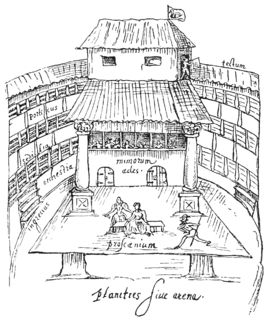
English Renaissance theatre, also known as Renaissance English theatre and Elizabethan theatre, refers to the theatre of England between 1558 and 1642.
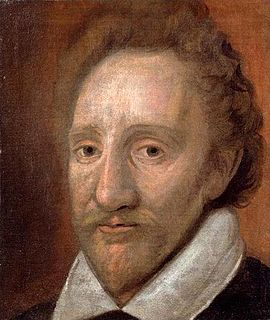
Richard Burbage was an English stage actor, widely considered to have been one of the most famous actors of the Globe Theatre and of his time. In addition to being a stage actor, he was also a theatre owner, entrepreneur, and painter. He was the younger brother of Cuthbert Burbage. They were both actors in drama. Burbage was a business associate and friend to William Shakespeare
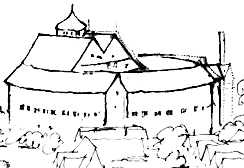
The Globe Theatre was a theatre in London associated with William Shakespeare. It was built in 1599 by Shakespeare's playing company, the Lord Chamberlain's Men, on land owned by Thomas Brend and inherited by his son, Nicholas Brend and grandson Sir Matthew Brend, and was destroyed by fire on 29 June 1613. A second Globe Theatre was built on the same site by June 1614 and closed by an Ordinance issued on 6 September 1642.
This article presents lists of the literary events and publications in 1600.
Philip Henslowe was an Elizabethan theatrical entrepreneur and impresario. Henslowe's modern reputation rests on the survival of his diary, a primary source for information about the theatrical world of Renaissance London.

The Rose was an Elizabethan theatre. It was the fourth of the public theatres to be built, after The Theatre (1576), the Curtain (1577), and the theatre at Newington Butts – and the first of several playhouses to be situated in Bankside, Southwark, in a liberty outside the jurisdiction of the City of London's civic authorities. Its remains were excavated by archaeologists in 1989.
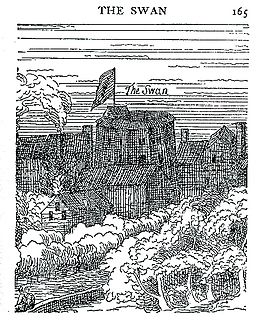
The Swan was a theatre in Southwark, London, England, built in 1595 on top of a previously standing structure, during the first half of William Shakespeare's career. It was the fifth in the series of large public playhouses of London, after James Burbage's The Theatre (1576) and Curtain (1577), the Newington Butts Theatre and Philip Henslowe's Rose (1587–88).
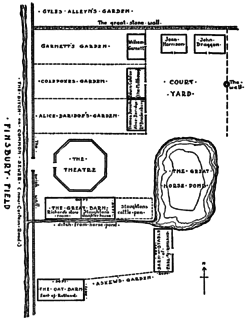
The Theatre was an Elizabethan playhouse in Shoreditch, just outside the City of London. It was the first permanent theatre ever built in England. It was built in 1576 after the Red Lion, and the first successful one. Built by actor-manager James Burbage, near the family home in Holywell Street, The Theatre is considered the first theatre built in London for the sole purpose of theatrical productions. The Theatre's history includes a number of important acting troupes including the Lord Chamberlain's Men, which employed Shakespeare as actor and playwright. After a dispute with the landlord, the theatre was dismantled and the timbers used in the construction of the Globe Theatre on Bankside.

Edward "Ned" Alleyn was an English actor who was a major figure of the Elizabethan theatre and founder of the College of God's Gift in Dulwich.
James Burbage was an English actor, theatre impresario, joiner, and theatre builder in the English Renaissance theatre. He built The Theatre, the first permanent dedicated theatre built in England since Roman times.

The Curtain Theatre was an Elizabethan playhouse located in Hewett Street, Shoreditch, just outside the City of London. It opened in 1577, and continued staging plays until 1624.
The Lord Chamberlain's Men was a company of actors, or a "playing company", for which Shakespeare wrote during most of his career. Richard Burbage played most of the lead roles, including Hamlet, Othello, King Lear, and Macbeth. Formed at the end of a period of flux in the theatrical world of London, it had become, by 1603, one of the two leading companies of the city and was subsequently patronized by James I.

Blackfriars Theatre was the name given to two separate theatres located in the former Blackfriars Dominican priory in the City of London during the Renaissance. The first theatre began as a venue for the Children of the Chapel Royal, child actors associated with the Queen's chapel choirs, and who from 1576 to 1584 staged plays in the vast hall of the former monastery. The second theatre dates from the purchase of the upper part of the priory and another building by James Burbage in 1596, which included the Parliament Chamber on the upper floor that was converted into the playhouse. The Children of the Chapel played in the theatre beginning in the autumn of 1600 until the King's Men took over in 1608. They successfully used it as their winter playhouse until all the theatres were closed in 1642 when the English Civil War began.

John Lowin was an English actor.
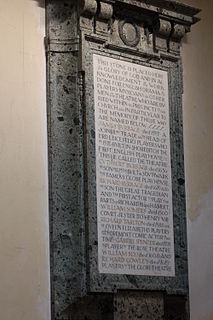
Cuthbert Burbage was an English theatrical figure, son of James Burbage, builder of the Theatre in Shoreditch and elder brother of the actor Richard Burbage. From 1589 he was the owner of the ground lease of the Theatre. Best known for his central role in the construction of the Globe Theatre, he was for four decades a significant agent in the success and endurance of Shakespeare's company, the King's Men.

William Sly was an actor in English Renaissance theatre, a colleague of William Shakespeare and Richard Burbage in the Lord Chamberlain's Men and the King's Men.
The Red Lion was an Elizabethan playhouse located in Whitechapel, just outside the City of London on the east side.

The Fortune Playhouse was a historic theatre in London. It was located between Whitecross Street and the modern Golden Lane, just outside the City of London. It was founded about 1600, and suppressed by the Puritan Parliament in 1642.
Henry Evans was the Welsh scrivener and theatrical producer primarily responsible for organising and co-ordinating the activities of the Children of the Chapel and the Children of Paul's at Blackfriars Theatre for a short period in 1583–84. He later led a consortium of investors who leased the theatre during a much longer second phase, after the property was revived by Richard Burbage and Cuthbert Burbage.
John Brayne was a member of the Worshipful Company of Grocers. He built the Red Lion playhouse, and financed, with his brother-in-law, James Burbage, the building of the Theatre in Shoreditch, in which he was to have had a half interest. He also leased the George Inn in Whitechapel with a friend, Robert Miles. The latter two ventures, particularly the financing of the Theatre, bankrupted him, and he fell out with both James Burbage and Robert Miles. It was suspected that his death in 1586 was caused by blows received during an altercation with Miles. His widow, Margaret, backed financially by Miles, was involved in litigation with Burbage over Brayne's half interest in the Theatre until her own death in 1593.
References
- ↑ W. Ingram, The Business of Playing: The Beginnings of the Adult Professional Theater in Elizabethan London (Cornell University Press, Ithaca and London 1992), p. 96 (Google). St Stephen Coleman Street Compound Register 1538-1598 (London Metropolitan Archives, ref. P69/STE1/A/001/MS04448), fol. 12 r. and fol. 24 r.
- ↑ St Stephen Coleman Street Compound Register 1538-1598, fol. 46 v.
- 1 2 3 4 Edmond, Mary (2008). "Street, Peter (bap. 1553, d. 1609)". Oxford Dictionary of National Biography . Oxford Dictionary of National Biography (online ed.). Oxford, England: Oxford University Press. doi:10.1093/ref:odnb/60976.(Subscription or UK public library membership required.)
- 1 2 3 4 5 6 7 Edmond, Mary (1993). Wells, Stanley (ed.). "Peter Street 1553–1609: Builder of Playhouses". Shakespeare Survey. Cambridge University Press. 45: 101–114. ISBN 0-521-42055-5. Preview at Google.
- 1 2 Gieskes, Edward (2006). Representing the professions: administration, law, and theater in early modern England. Newark, DE: University of Delaware Press. pp. 186–7. ISBN 0-87413-929-5.
- ↑ Bowsher, Julian; Miller, Pat (2009). The Rose and the Globe—playhouses of Shakespeare's Bankside, Southwark. Museum of London. p. 108. ISBN 978-1-901992-85-4.
- ↑ Shapiro, James (2005). 1599: A year in the life of William Shakespeare. London: Faber. p. 2. ISBN 0-571-21480-0.
- ↑ Shapiro (2005: 5)
- 1 2 Shapiro (2005: 123–6)
- 1 2 An Execration upon Vulcan, Jonson's commemoration of the Globe's destruction by fire in 1613
- ↑ Bowsher; Miller (2009: 90)
- ↑ Adams, John Cranford (1961). The Globe Playhouse. Its design and equipment (2 ed.). London: John Constable. OCLC 556737149., quoted in Bowsher and Miller (2009: 90)
- ↑ Shapiro (2005: 129)
- ↑ Aaron, Melissa (2012). "Theatre buildings, admissions, prices, and playing seasons". In Kinney, Arthur F (ed.). The Oxford Handbook of Shakespeare. Oxford, England: Oxford University Press. pp. 421–425. ISBN 978-0-19-956610-5.
- ↑ Kinney, Arthur F. (2003). Shakespeare by stages: an historical introduction . Oxford, England: Blackwell. p. 7. ISBN 0-631-22468-8.
- ↑ Orrell, John (1994). "The Architecture of the Fortune Playhouse". Shakespeare Survey: Playing Places for Shakespeare. Cambridge, England: Cambridge University Press. 47: 15–28. doi:10.1017/ccol0521470846.002. ISBN 0-521-47084-6.
- ↑ Heaney, Seamus (1965). Hall, Jason David (ed.). Eleven Poems. Belfast: Festival. OCLC 2362433.